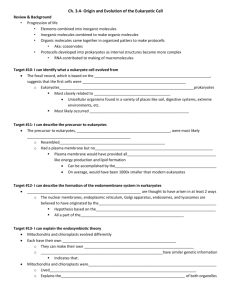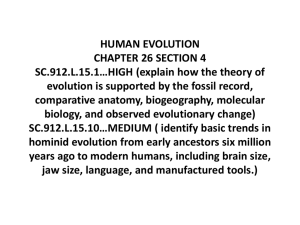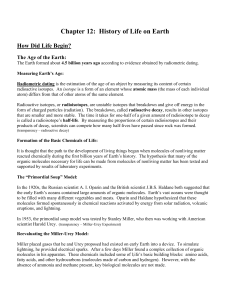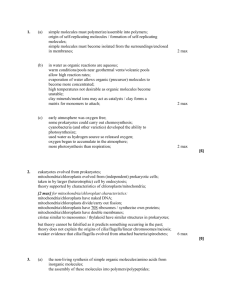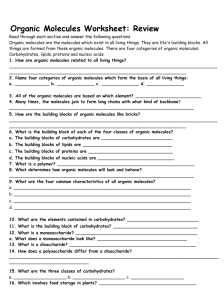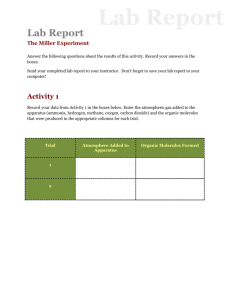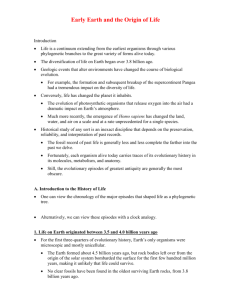Paper 3 Modified Mark scheme
advertisement
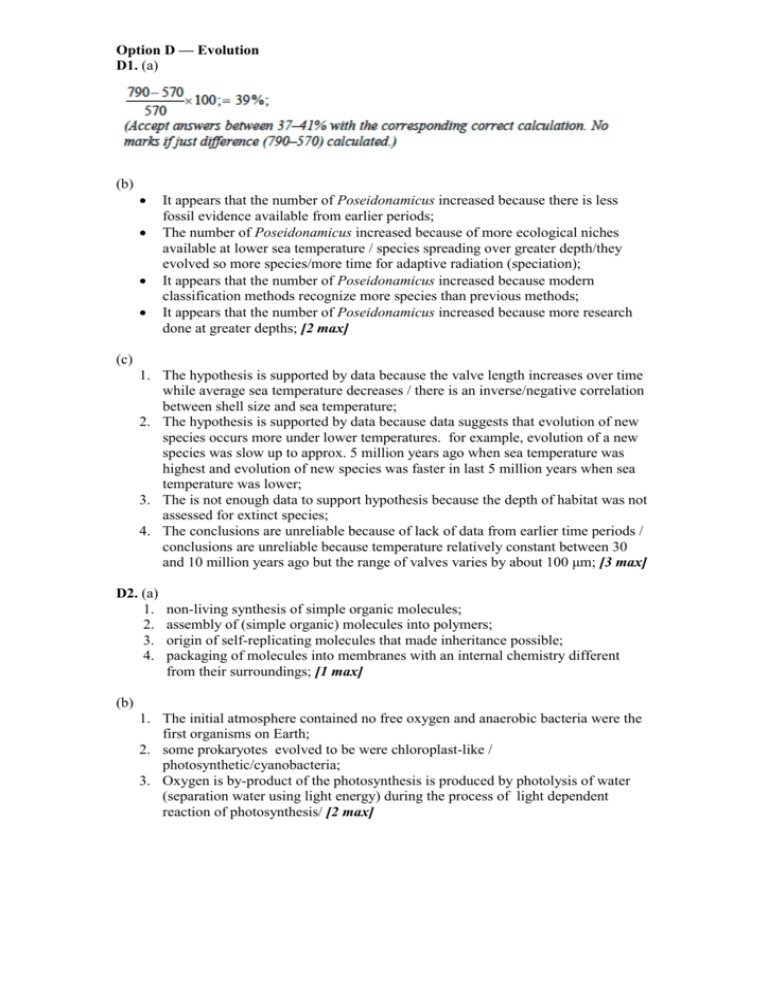
Option D — Evolution D1. (a) (b) It appears that the number of Poseidonamicus increased because there is less fossil evidence available from earlier periods; The number of Poseidonamicus increased because of more ecological niches available at lower sea temperature / species spreading over greater depth/they evolved so more species/more time for adaptive radiation (speciation); It appears that the number of Poseidonamicus increased because modern classification methods recognize more species than previous methods; It appears that the number of Poseidonamicus increased because more research done at greater depths; [2 max] (c) 1. The hypothesis is supported by data because the valve length increases over time while average sea temperature decreases / there is an inverse/negative correlation between shell size and sea temperature; 2. The hypothesis is supported by data because data suggests that evolution of new species occurs more under lower temperatures. for example, evolution of a new species was slow up to approx. 5 million years ago when sea temperature was highest and evolution of new species was faster in last 5 million years when sea temperature was lower; 3. The is not enough data to support hypothesis because the depth of habitat was not assessed for extinct species; 4. The conclusions are unreliable because of lack of data from earlier time periods / conclusions are unreliable because temperature relatively constant between 30 and 10 million years ago but the range of valves varies by about 100 μm; [3 max] D2. (a) 1. 2. 3. 4. non-living synthesis of simple organic molecules; assembly of (simple organic) molecules into polymers; origin of self-replicating molecules that made inheritance possible; packaging of molecules into membranes with an internal chemistry different from their surroundings; [1 max] (b) 1. The initial atmosphere contained no free oxygen and anaerobic bacteria were the first organisms on Earth; 2. some prokaryotes evolved to be were chloroplast-like / photosynthetic/cyanobacteria; 3. Oxygen is by-product of the photosynthesis is produced by photolysis of water (separation water using light energy) during the process of light dependent reaction of photosynthesis/ [2 max] (c) 1. Organic compounds/ molecules could have evolved in water as organic reactions are aqueous; 2. Organic compounds/ molecules could have evolved in warm conditions/pools near geothermal vents/volcanic pools, because warm conditions allow high reaction rates; 3. Organic compounds/ molecules could have evolved in small pools where evaporation was high because evaporation of water allows organic (precursor) molecules to become more concentrated; 4. O Organic compounds/ molecules probably did not evolve high temperatures not desirable as organic molecules become unstable; 5. Organic molecules could have polymerized on clay minerals/metal ions because clay minerals/metal ions may act as catalysts / clay forms a matrix for monomers to attach; 2 max D.3. a. 1. The theory states that eukaryotes cells evolved from prokaryotes cells; 2. This theory explains how the organelles in eukaryotes, mitochondria/chloroplasts evolved from (independent) prokaryotic cells; 3. Prokaryotic cells with similar features to mitochondria/chloroplasts were taken in by larger heterotrophic prokaryote cell by endocytosis; 4. This theory is supported by characteristics of chloroplasts/mitochondria that are similar to prokaryotes; 5. mitochondria/chloroplasts have naked DNA similar to prokaryotes; 6. mitochondria/chloroplasts divide/carry out fission similar to prokaryotes; 7. mitochondria/chloroplasts have 70S ribosomes / synthezise own proteins similar to prokaryotes; 8. mitochondria/chloroplasts have double membranes similar to prokaryotes; 9. The cristae similar to mesosomes / thylakoid have similar structures in prokaryotes; 10. There are some problems with the theory for example the theory cannot be falsified as it predicts something occurring in the past; 11. There are some problems with the theory for example the theory does not explain the origins of cilia/flagella/linear chromosomes/meiosis; 12. There is some weaker evidence that cilia/flagella evolved from attached bacteria/spirochetes; 6 max b 1. self-replicating and catalytic activities of RNA; 2. short sequences of RNA have been able to duplicate/copy other RNA molecules accurately; 3. RNA enzyme/ribozyme (able to synthesize other molecules); 4. 3-dimensional structure of ribosome catalytic sites (for peptide formation) are composed of RNA; 5. able to store information in sequence of (4) nucleotides (similar to DNA); 2 max c. 1. The Miller-Urey Experiment simulated conditions of pre-biotic earth (in closed container) to test the idea that organic molecules could have originated in early earth’s environment ; 2. This container contained a mixture of water vapour, ammonia, methane, hydrogen / reducing atmosphere; 3. This mixture was ignited with sparks/electric (discharge to simulate lightning); 4. The gas was cooled in a condenser / cooling of mixture and a liquid was obtained; 5. In this liquid there were amino acids. The results from this experiment suggests that simple organic molecules could have formed in the prebiotic conditions on Earth. H1. (a) 625 % (percentage required) (accept answers in the range of 600 % to 650 %) [1] (b) (i) a. pH rises in Hyde Park and falls along Oxford Street; b. back to pre-walk level in six hours in Hype Park but not along Oxford Street; [2] (ii) a. b. c. d. e. (iii) asthma (attack) constricts bronchioles (while walking); exercise/walking increases cell respiration producing more CO2; lower ventilation causes CO2 build-up thus lower pH; CO2/pollutants in the air could be causing/triggering acidification; inflammation (by-products) lower pH; [2 max] This hypothesis is support by the data because bronchioles constriction is demonstrated by the lower pH of the participants on oxford street; This hypothesis is support by the data because oxford street participants has higher inflammation measured by higher amounts of myeloperoxidase; [1 max] (c) allergens / dust mites / pollen / cold (temperature) / viral illness / exercise / anxiety/stress [1] Award [1] for any two causes. (b) (i) Award [1] for two correct glands. a. salivary glands; b. gastric glands; c. pancreas; d. wall of the small intestine; [2 max] (ii) a. pepsinogen converted to pepsin by stomach acidity/low pH/HCl; b. trypsinogen converted to trypsin by enteropeptidase/enterokinase in small intestine; [2] H3. (circulation of blood through liver tissues – accept properly annotated diagram) a. hepatic artery brings oxygenated blood from the heart; b. hepatic portal vein brings nutrients from small intestine; c. Hepatic portal veins divide into smaller vessels that merge to form sinusoids where liver cells/hepatocytes store and regulate nutrients; d. Deoxygenated and low nutrient blood leaves through hepatic vein; e. hepatocytes regulate blood sugar level by storing glucose as glycogen / releasing glucose from breakdown of glycogen (facilitated by arrival from portal vein); f. Hepatocytes under influence of insulin will regulate blood sugar level by storing glucose as glycogen and under influence of glucagon release glucose from the breakdown of glycogen ; g. blood lipids/cholesterol synthesized/broken down if required / secreted through bile; h. iron stored from breakdown of hemoglobin/released when Po2 is low;
